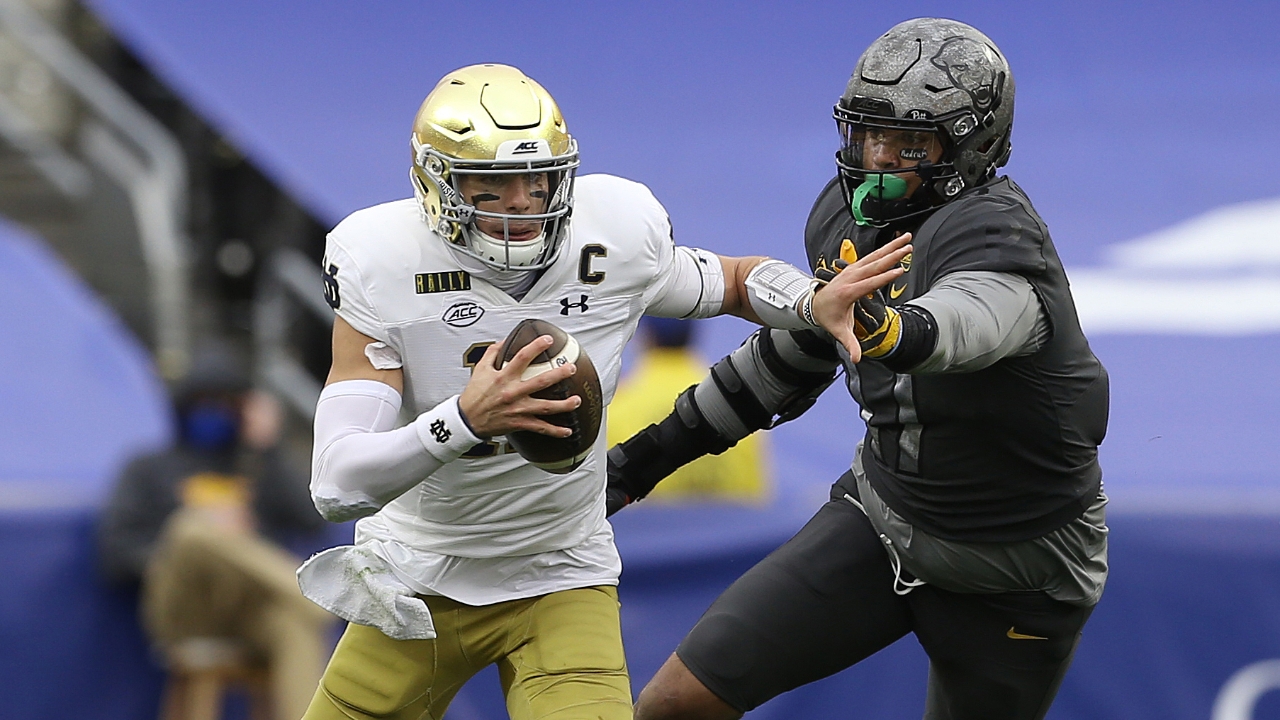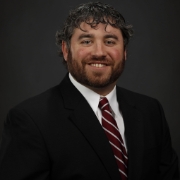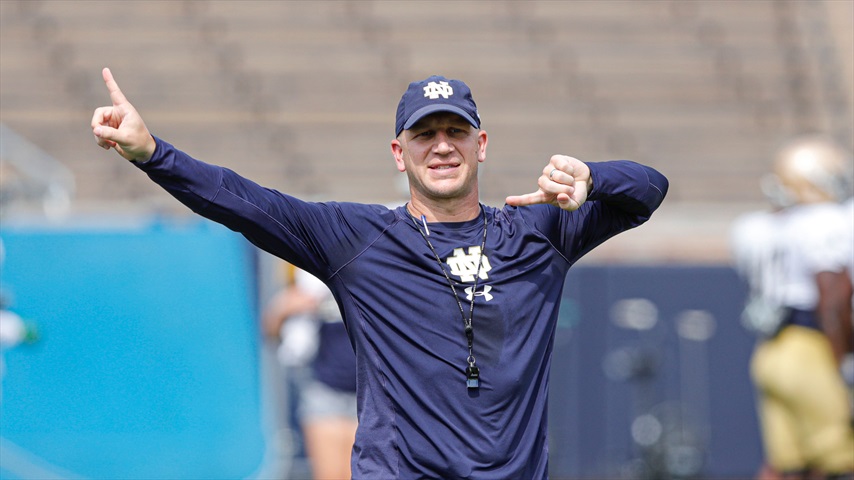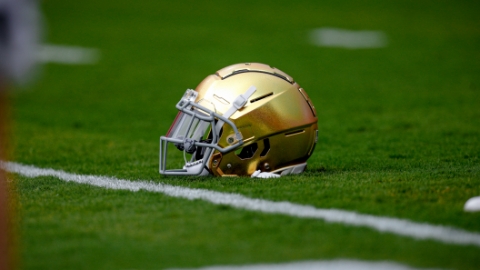Talking X's & O's with Notre Dame DC Clark Lea & Alabama DC Pete Golding

Asked on Monday whether today’s Spread Offenses will eventually be relics of the sport the way the Wishbone is now, Alabama defensive coordinator Pete Golding said, in terms of principles, the Spread Offense essentially is the Wishbone.
“Most of this is triple-option,” Golding explained. “I mean, it's the run-pass option, but now it's vertical. It used to be, ‘Hey, read and ride our pitch.’ Well, he just caught it seven yards behind the football. So you had time to rally guys and he had to build his speed up and all that.”
Similarly, the resurgence of quarterbacks as threats to run the football is again forcing defenses to account for all 11 offensive players.

“Once you start trying to take away matchups because there's a really good player that we need to double, because we probably can't cover him one-on-one, well, now you're down a guy,” he said.
“I think that's the big thing. They make you cover the width of the field horizontally and vertically, and then they make you account for the quarterback in the run game, which is tough to do. There's only so many coverages you can play and be sound versus all those.”
Notre Dame defensive coordinator Clark Lea is trying to solve the same numbers puzzle.
“As long as teams have the ability to spread the field out, and in particular to run the quarterback, you're always going to be forced to defend with all 11 players, meaning every single person, you'll be zeroed out,” Lea said on Tuesday. “Every person is going to have a responsibility.
“Until you have a guy that can cover two responsibilities, then you're one-for-one across the board and you better win your one-on-ones.”
Florida put up 46 points against Golding’s unit in the SEC Championship two weeks ago by winning its favorable matchups and going Empty to get pre-snap reads on what the Crimson Tide were playing and whether they were trying to take away tight end Kyle Pitts or receiver Kadarius Toney on the play.
“‘All right, what's the picture?’” Golding said, putting himself in the shoes of the Gator decision-makers. “‘What are they in? All right, now they're doubling so-and-so, 84 (Pitts) or 1 (Toney). Now they have nobody for the quarterback.’
“If you're not gaming the front and somebody doesn't win up front, well, you're a gap short.”
Toney caught eight passes for 153 yards and a touchdown while Pitts brought in seven for 129 yards and a score against Alabama.
“I think a lot of times now you've got to win one-on-one,” Golding said. “I think that's what defense has come to.
“If you can't win that one-on-one and you can't change the picture and obviously confuse a guy, dictate the read, knowing, ‘Hey, he's the read-and-ride player, we're going to show this, pop back out, influence the play like you used to do in triple,’ then you're going to struggle.”

Lea said losing those one-on-ones can lead to explosive plays. Clemson hit the Irish with multiple explosive plays in the ACC Championship, including a 67-yard scoring pass, a 44-yard scoring run and a 34-yard touchdown run.
“Where offenses have become so complicated is that they've found ways to isolate you,” says Lea. “And if your DB is one step behind or if your linebacker is leveraged an inch off the body and the ball's caught, he can run into a lot of space.”
Lea has been struck by the creativity and “willingness to continue to push the envelope for what's possible” of offenses.
“What these teams are asking of their quarterbacks, how they're using tempo and then hard counts and scans to undress shells, it is relentless,” he said.
After finally coming up with some answers to the Spread/Zone Read concepts teams like West Virginia and Oregon specialized in 15 years ago, the questions on the tests have since changed.
“Now you're dealing with this whole new version where the side of the read, the movement of the back, and like I said, the running of the quarterback,” said Lea. “You're requiring your players to win their one-on-ones, to be impeccable when it comes to the execution of the defense and their responsibility. And then you pay with explosive-play touchdowns when you miss in the execution.”
While playing fast, physical and running to the football will always be paramount to playing sound defense, Lea and defensive coaches across the country lock themselves in the lab each offseason, looking for answers, “new ways and creative ways to change the way we can diagnose, to change the way we recognize formation.”
“Certainly, we will catch up, and I also think that offenses will continue to evolve,” Lea continued. “That's what makes this fun. It's what makes it an exciting line of work. As a teacher, there is no such thing as a concept set in stone. It may be set in stone for a year, but someone somewhere is going to find a way to break that concept and you're going to have to adapt it to stay relevant.
“And so that's the challenge of a defensive coordinator, and that's also what's exciting.”
That’s also the challenge defensive players on both teams will face during Friday’s College Football Playoff Semifinal at the Rose Bowl in Dallas.
Who wins more of those one-on-one opportunities will be one of the game’s greatest deciding factors.
